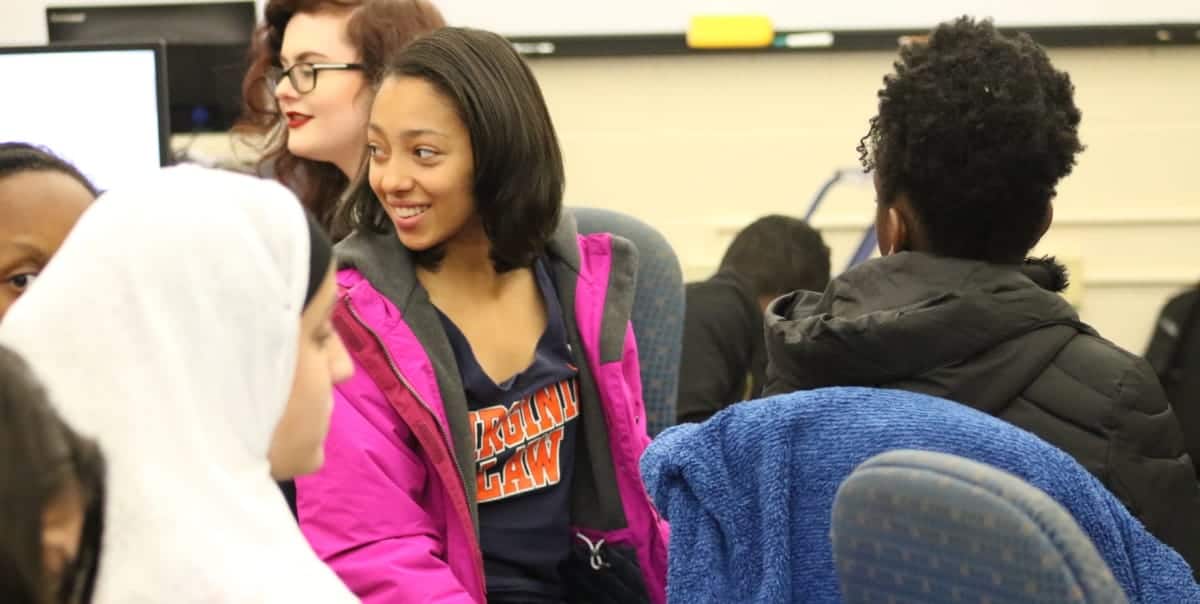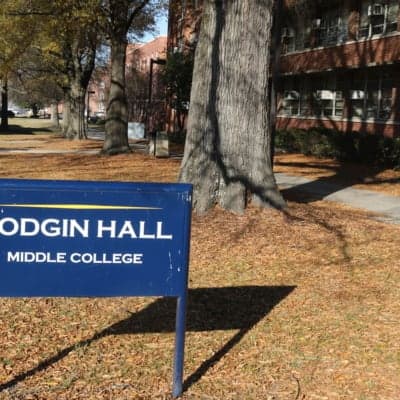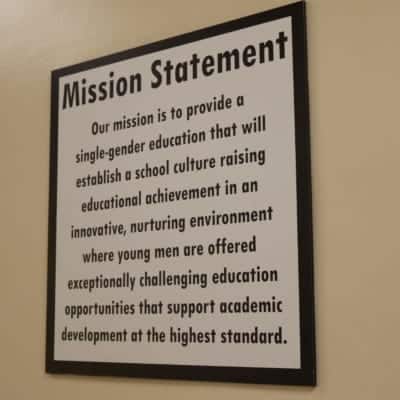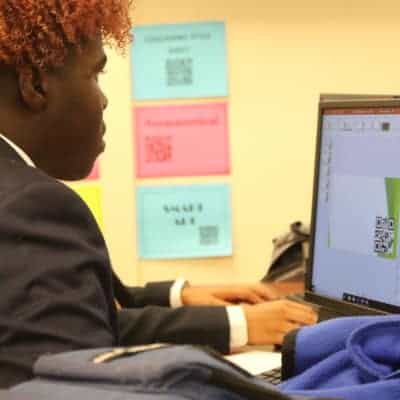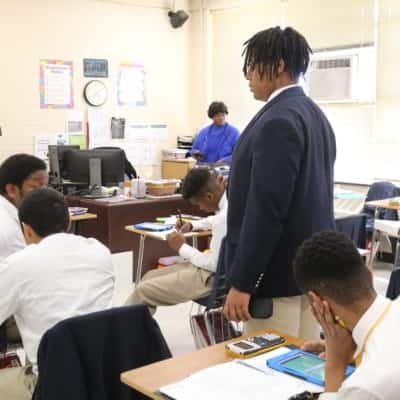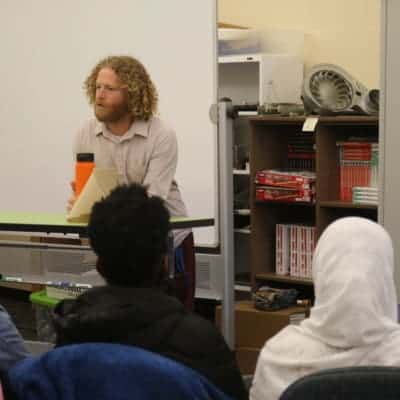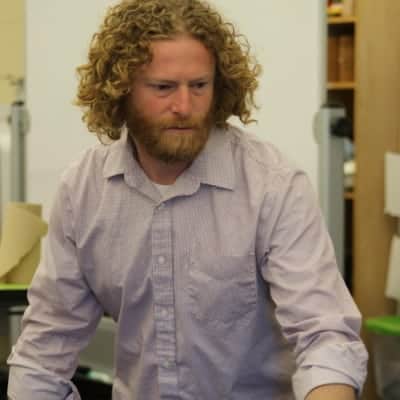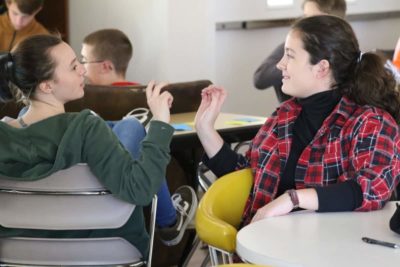Throughout the week, EducationNC has looked at Cooperative Innovative High Schools (CIHS), which include early colleges, middle colleges, and other schools with innovative models and focuses. There are over 130 statewide, and they have some things in common. They offer the chance for students to earn college credits while in high school. Most are located on the campus of an institution of higher education. And they have small classroom environments and personalized instructional strategies.
But there is also a great deal of diversity both within the model and — for North Carolina A&T State University — on the same campus. The largest Historically Black College or University (HBCU) in the country located in Greensboro, NC A&T hosts two very different CIHS’s. The flexibility of the CIHS designation allows schools to be built around what works for their particular students.
“These schools do a really good job of personalizing supports for their students, of knowing their students well and leveraging those relationships to improve outcomes for students,” said Isaac Lake, a state consultant for DPI’s division of advanced learning and gifted education.
Intentionality and personalization are threaded throughout the designs of The Middle College at NC A&T and The STEM Early College at NC A&T. Let’s take a look at both schools and their leaders’ visions for their students.
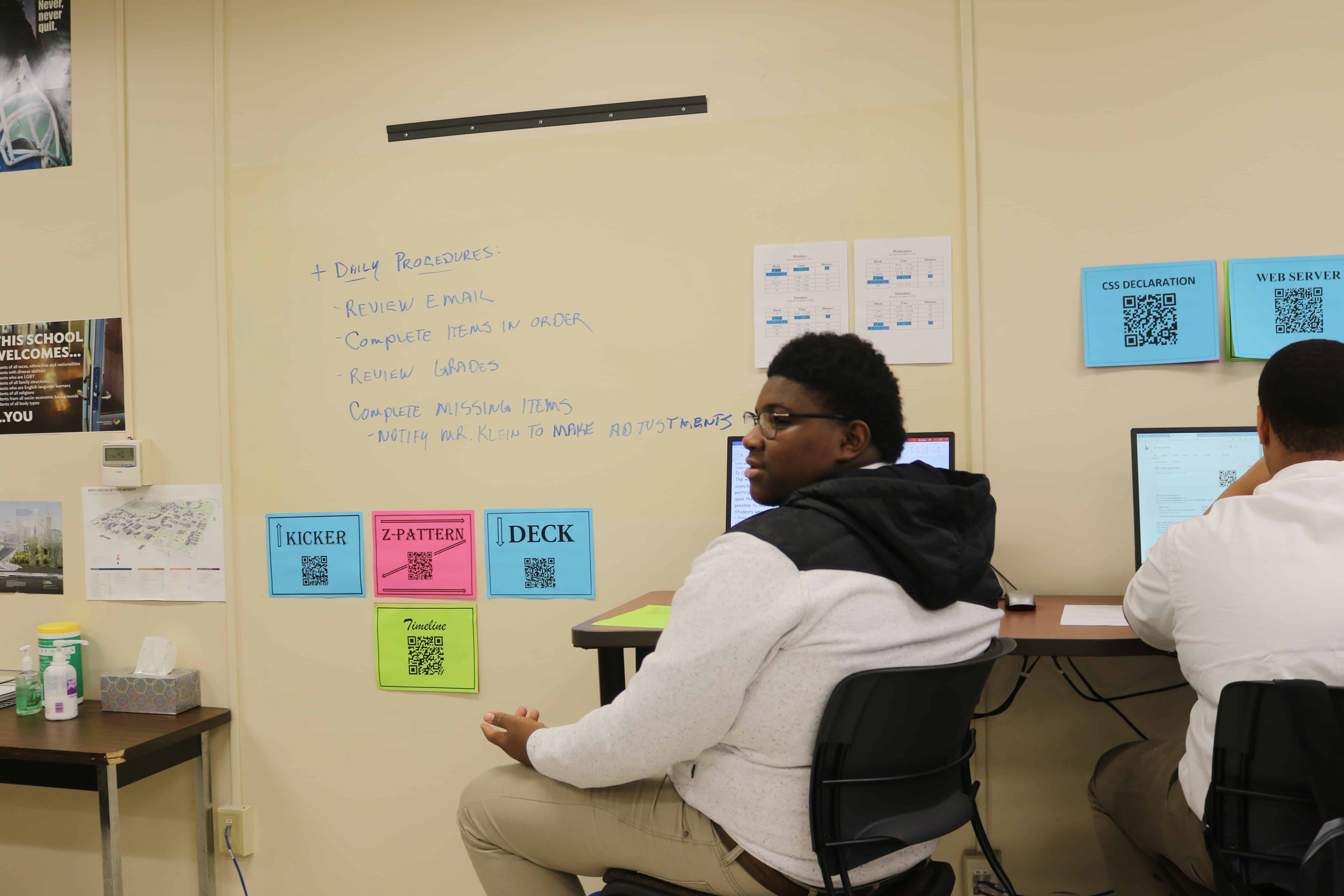

Travis Seegars is in his second year as principal at The Middle College, but the school is not new to him. Seegars attended NC A&T as an undergraduate student. His father went to the university and now teaches there. His mother is also an NC A&T graduate and used to have the office Seegars now works in daily. Seegars also met his wife in the building that now holds the all-male high school, which recruits students struggling in a traditional school setting.
“Coming here, it was a dream school,” Seegars said. He said he wanted to be able to connect with students on a personal level and have a large impact.
There are only 126 students at The Middle College, which is celebrating eight years with a 100 percent graduation rate. The students are majority minority — 87 percent of students are black and 9 percent are Hispanic. Seegars said almost half of the students come from a low-income background. Though students struggling in high school are targeted as part of the model, he said there are a wide variety of academic and social backgrounds that lead students to the school.
Unlike early college students, most students at The Middle College do not receive an associate degree during their high school years. Students take high school courses all four years, with college courses sprinkled in according to a student’s interests and needs. Last year, Middle College students were able to take college courses as early as sophomore year for the first time, and Seegars said the students have been successful so far.
“We figure out different points to anchor them along the way to high school and to college,” Seegars said.
Though high school students entering The Middle College may be struggling in a traditional school setting, Seegars said the school has worked with the university to create a list of college courses that meet students where they are.
“We may have a student that traditionally wouldn’t be your best college student but no, we’re going to place them into this college class and give them that experience and exposure.”
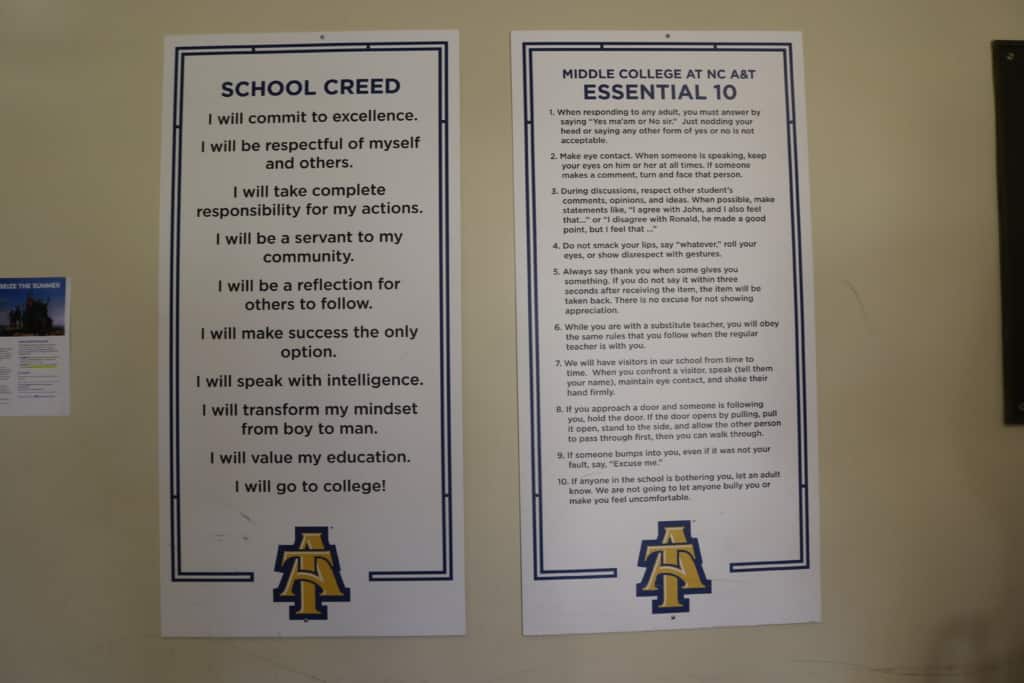

The small number of students leads to a school culture to which Seegars attributes much of the school’s success. Students are close with each other and with their instructors and leaders. There are high expectations for behavior and academic performance. Students wear their “Aggie Attire” school uniform every Wednesday. The school creed, pictured above, is recited daily and includes promises of respect for others, leadership, service, and excellence. Its final commitment: “I will go to college!”
The students recognize efforts from Seegars and other teachers to get to know students one-on-one.
“They really make a bond with you,” said Ryan Barnes, a ninth grader at the school. Tenth grader Osmane Ide chimed in that almost every student has Seegers’ cell phone number. They recommend games for Seegars to play and like to make fun of his video game abilities. Small points of contact like these lead to an increase in student motivation, Seegars said.
“The second a young man is able to build that rapport or build that relationship, that student’s going to want to do more and more,” Seegars said. “They’re going to go above and beyond.”
The all-male environment is one Seegars finds helpful for the adolescents at his school. There are not as many distractions or reasons to fight among each other, he said.
“It’s a little different, coming from a boy-girl school, but you learn to get used to it,” Barnes said. “These guys, they tend to become your brothers and you’re with them until the end. It becomes more of a family than just a school.”
Ide agreed with Seegars that males connect better without relationships with female students to worry about. “There’s no drama, like nothing actually happens that would lead to a fight,” he said.
Seegars said his predecessor was a larger-than-life character that he admires and seeks advice from often. His shoes were big ones to fill. In his second year as principal, Seegars said he has come into his own as a leader and gotten to know the students better. He also has begun to look at what makes the school different besides its college access.
“I want to learn the Middle College at A&T way,” he said. “So if we’re constantly saying, ‘We’re not a traditional high school, we’re a small school setting, we’re a family,’ I wanted to see what are we doing different in the classrooms.”
A smaller school also means smaller class sizes at The Middle College. Barnes said it’s easier to know what a teacher is talking about when teachers can focus on individual students.
Seegars also found teachers were on board with the idea that, “The day of sit and get is over.” To keep young male students with lots of energy engaged, teachers keep students active and switching from one activity to the next. This idea is backed by research that ties physical activity to improved cognition. That may mean jumping from watching a video, to sharing out, then working in groups, writing on scrap paper in the halls, then coming back inside to do research on their cell phones, Seegars said. “We constantly have our students moving.”
The model, Seegars said, allows access to college credits and college-going culture throughout high school without an expectation to finish a full two years of college in high school. Students have classes with regular college students, go on tours at other universities in- and out-of-state, are recognized at NC A&T’s graduation each year, and many (between 30 and 40 percent) stay on NC A&T’s campus after high school.
The tight-knight community allows male students to express themselves openly, Seegars said. Students work on communication skills often, and Seegars encourages teachers to push students outside of their comfort zones.
“I think with young men, that’s an important piece,” he said. “Young men do not want to feel vulnerable. If they do feel vulnerable and you slap their hand back in their face or you shun them for that, they’re less likely to do it again.”
Watch below as Principal Seegars talks about why he thinks The Middle College’s environment encourages struggling students.
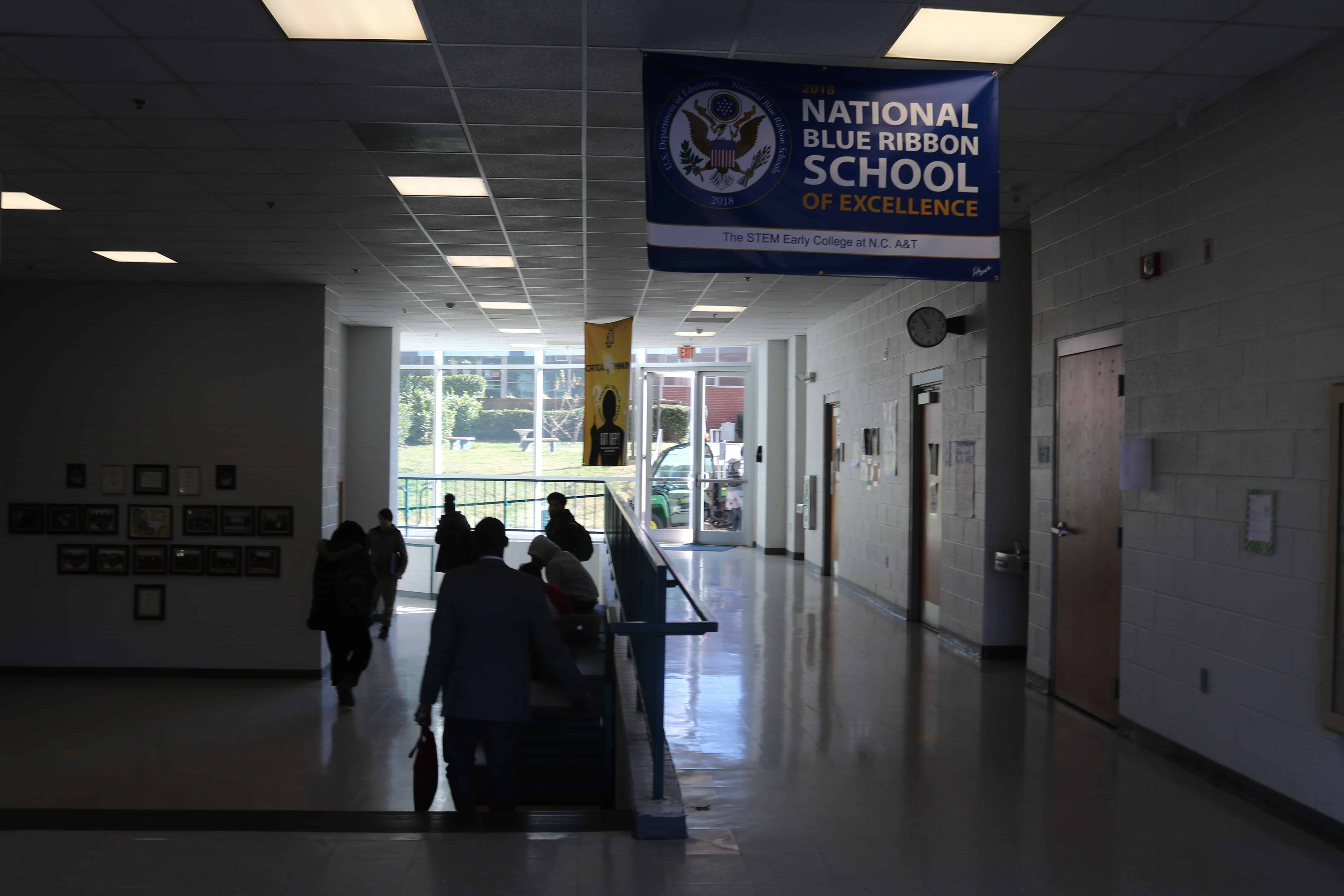

Any aspect you can think of at The STEM Early College is somehow tied to its subject focus. Eighth-grade applicants are interviewed on how their interests and career goals align with science, technology, engineering, and math. Projects in other subjects are often viewed through a STEM lens. When juniors begin to take college courses, the school’s four pathways are STEM-focused: biology, information technology, engineering, and sustainable resources.
“We try to attack it from all angles,” said Jamisa Williams, who has been the principal at The STEM Early College for four years and was attracted to the school in large part because of her passion for STEM education. “We really want them to have a fully-immersed STEM experience.”
The STEM Early College is also a Cooperative Innovative High School, offering students college credits and experiences while in high school, but differs greatly from The Middle College. Instead of targeting students struggling academically in a traditional setting, the college creates opportunities for students who need more of an academic challenge than their traditional school settings are providing. Students go through a competitive application process to be accepted. The early college has a 100 percent graduation rate and 100 percent of students go on to four-year universities.
While much of the content is somehow tied to STEM, Williams said students are being taught broader skills that prepare them for careers in areas that are rapidly changing and progressing.
“I think everybody has heard the projection that many of the students who are in high school now will graduate and have jobs that aren’t even created yet,” Williams said. “And so you can’t prepare a student for something that doesn’t exist, other than to teach them how to think and solve problems, and evaluate the world for problems.”
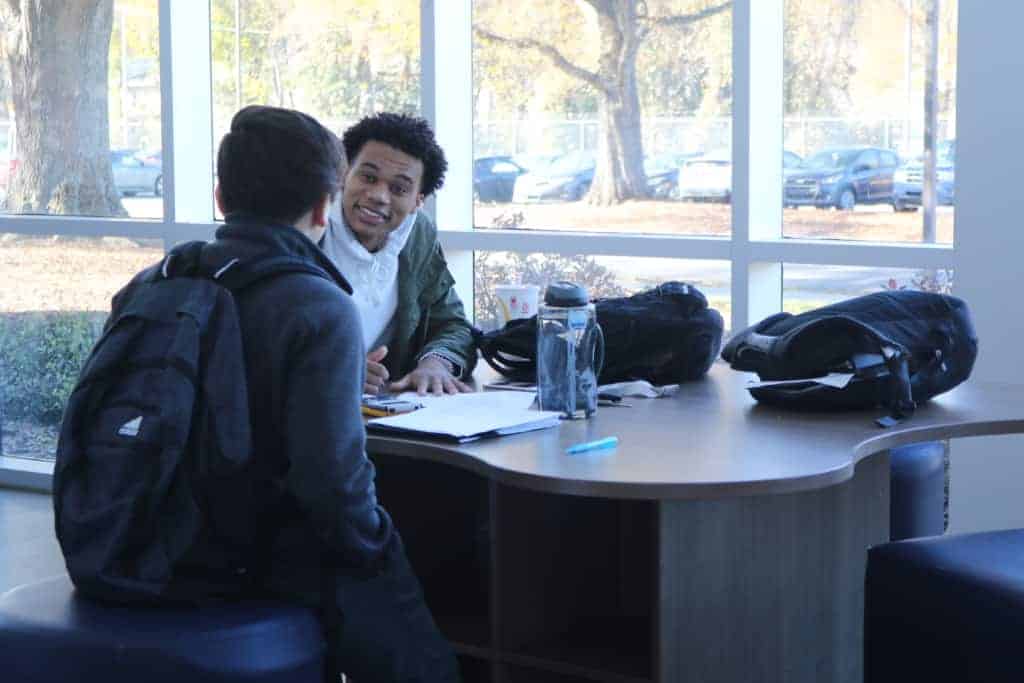

In their capstone projects, students are challenged to do just that — ask tough questions, solve problems, work in groups, research, and present. They are encouraged to tackle real-world issues that can help them connect STEM to other disciplines. For Ryyan Pritchet, a senior at The STEM Early College, one of her projects combined hard science and social science by taking a problem she saw — a lack of healthy hair products for black women — and looking at the science of how to create an organic option.
“We’ll walk into a store, and there would only be a small selection for us,” Pritchet said. “Over the years, we’ve seen the hair products for curly hair expand, but we also noticed that a lot of these products have a lot of chemicals. So we wanted to make our own organic product.”
She said a lot of her work at the early college has aimed to build connections between STEM and her other interests. Pritchet plans to study public policy in college because of its interdisciplinary nature.
“For me, I really like to intersect the two. I feel like there’s not enough of that … that’s what a lot of my work at STEM has been, intersecting the two and showing people that you can have diverse abilities. You don’t have to be just good in one subject.”
Williams said her main challenge over her time as principal has been getting students who are used to succeeding academically to be okay with failure. This is part of how the school tailors its focus to both its students’ strengths and challenges.
“I always talk about the ‘in spite of,'” she said. “Our students are going to perform in spite of us. So like what is the part of what we offer here that builds upon what they’re going to do naturally as advanced students?”
When she arrived at the school, Williams said the culture was more grade-driven. Adding service learning to student projects and focusing more on character education have been two ways the school is teaching students what ‘smart failure’ means.
“We want our students to understand that solving the problems of the world doesn’t come with one try,” she said. “And so that one try may be equivalent to a grade for them, but for us it’s equivalent to the process, the learning, the iteration, and the growth.”
Pritchet said a diverse mix of student backgrounds and personalities, along with close relationships with teachers, has created a setting that feels community-driven and focuses on the process of learning.
“I feel like at a lot of these accelerated school programs, it can be very competitive because students are very caught up in having the best grades, but like at STEM, we don’t have rankings, we don’t have No. 1 top of the class… Students are less concerned about beating each other and I feel like it’s very collaborative. We always talk about how we’re going to miss having this learning environment when we go to college.”
Watch below as Williams expands on how she feels the CIHS model allows for intentional leadership.
As Matt Vaughn taught his CTE class at STEM Early College, he took a break for a discussion that showcased the character education Williams mentioned. He asked his students whether they enjoyed group or individual work more and broke down a student’s response who said doing things herself was easier and produced better results. One student had held a community event related to a school project the night before where not as many people attended as he had hoped. Vaughn bridged the two situations to talk about the value of frustration.
Vaughn said he wants to give students perspective and experiences that help them navigate the accelerated atmosphere of early college. No matter the academic level of students, they need support and tools to grow as individuals.
“The challenge of early college for the students is taking them not necessarily in skills but taking them from a middle school level of maturity to a college level of maturity in two years,” he said.
Vaughn said he often thinks about whether or not the benefits of the early college model he has seen could be achieved in a traditional high school. He said he is not convinced the model in itself is what works for students, but the ability to constantly have a conversation around growing students’ maturity and providing challenging opportunities before students leave high school.
“I don’t know if we’d have that conversation as urgently if we weren’t an early college,” he said. “It isn’t that it shouldn’t or can’t happen in a traditional high school. There are just usually bigger fish to fry.”
